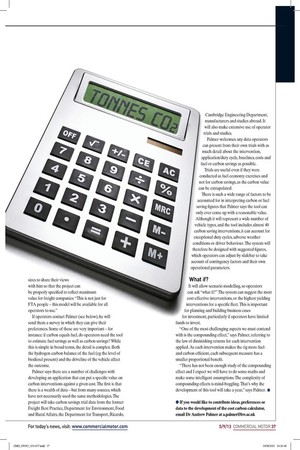Cutting your footprint The cost and benefits of carbon interventions
Page 28

Page 29

If you've noticed an error in this article please click here to report it so we can fix it.
are hard to quantify and non-standardised, but a new tool from Heriot-Watt and the FTA could change that Words: Louise Cole UNDER DEVELOPMENT
Turners (Soham) and Isotrak recently developed a fuel-efficiency programme, which won a Logistics Carbon Reduction Scheme (LCRS) award and is a good example of the type of trial data that Andrew Palmer hopes can be used to develop the carbon cost calculator. The fuel management programme tackles the problem of planned versus actual routeing, with alternative driver routes identified, assessed and mapped in red, amber and green to indicate preference. Isotrak's tracking system is coupled with route
compliance reports. The system also monitors driving style and highlights the best ways to drive specific vehicles so that actual performance figures can be compared with
manufacturer's data.
It is an industry axiom that fuel equals carbon, which equals cost. If we can save carbon, we can save fuel and save money. Furthermore, the UK is bound by government targets to cut 80% of its greenhouse gas emissions by 2050. It has always been difficult for operators to accurately assess the effect of carbon/fuel interventions, and plot their benefit against their cost. Without standardised data, it is guesswork where operators should invest their hard-earned cash for maximum benefit.
A solution is on the horizon with a development project being spearheaded by Dr Andrew Palmer, research fellow at Heriot-Watt Logistics Research Centre, and his colleagues, who intend to improve and relaunch a tool first conceived by Professor Alan McKinnon and the Freight Transport Association (FTA) — the carbon calculator. Although clever, the carbon calculator was not a particularly sophisticated tool and the FTA isn't certain how many companies have used it. However, Palmer hopes to make the tool far more pertinent to the logistics industry by finding useful values for carbon savings and a cost per intervention. The work will be carried out under the auspices of the Centre for Sustainable Road Freight, a joint enterprise between Cambridge University's engineering department
and Heriot-Watt's logistics department, with backing from the Engineering and Physical Sciences Research Council and the industry (including John Lewis, Tesco, DHL, Wincanton, Volvo Trucks, Goodyear and Firestone). It is also supported by the FTA as the tool was part of its Logistics Carbon Reduction Scheme. Palmer expects the work to take approximately one year, but first he needs to establish what the industry wants the project to achieve. Tools for the future "There are plenty of carbon calculators for existing operations but we do not have calculators for future operations," says Palmer. He is keen for operators of all sizes to share their views with him so that the project can
be properly specified to reflect maximum value for freight companies. "This is not just for FTA people — this model will be available for all operators to use."
If operators contact Palmer (see below), he will send them a survey in which they can give their preferences. Some of these are very important — for instance: if carbon equals fuel, do operators need the tool to estimate fuel savings as well as carbon savings? While this is simple in broad terms, the detail is complex. Both the hydrogen-carbon balance of the fuel (eg the level of biodiesel present) and the driveline of the vehicle affect the outcome. Palmer says there are a number of challenges with developing an application that can put a specific value on carbon interventions against a given cost. The first is that there is a wealth of data — but from many sources, which have not necessarily used the same methodologies. The project will take carbon savings trial data from the former Freight Best Practice, Department for Environment, Food and Rural Affairs, the Department for Transport, Ricardo,
Cambridge Engineering Department, manufacturers and studies abroad. It will also make extensive use of operator trials and studies. Palmer welcomes any data operators can present from their own trials with as much detail about the intervention, application/duty cycle, baselines, costs and
fuel or carbon savings as possible. Trials are useful even if they were
conducted as fuel economy exercises and not for carbon savings, as the carbon value can be extrapolated. There is such a wide range of factors to be accounted for in interpreting carbon or fuel saving figures that Palmer says the tool can only ever come up with a reasonable value. Although it will represent a wide number of
vehicle types, and the tool includes almost 40 carbon saving interventions, it can account for exceptional duty cycles, adverse weather conditions or driver behaviour. The system will therefore be designed with suggested figures, which operators can adjust by slidebar to take account of contingency factors and their own operational parameters.
What if? It will allow scenario modelling, so operators can ask "what if?" The system can suggest the most cost-effective interventions, or the highest yielding interventions for a specific fleet. This is important for planning and building business cases for investment, particularly if operators have limited
funds to invest.
"One of the most challenging aspects we must contend with is the compounding effect," says Palmer, referring to the law of diminishing returns for each intervention applied. As each intervention makes the rig more fueland carbon-efficient, each subsequent measure has a smaller proportional benefit. "There has not been enough study of the compounding effect and I expect we will have to do some maths and make some intelligent assumptions. The complexity of compounding effects is mind-boggling. That's why the development of this tool will take a year," says Palmer. • • If you would like to contribute ideas, preferences or data to the development of the cost carbon calculator, email Dr Andrew Palmer at a.palmer@hw.ac.uk









































